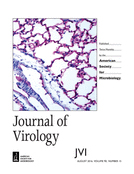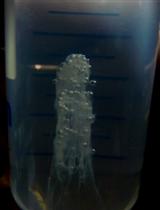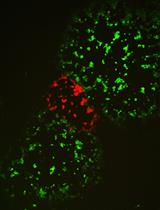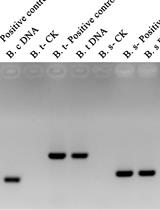- EN - English
- CN - 中文
Analysis of Replicative Intermediates of Adeno-associated Virus through Hirt Extraction and Southern Blotting
通过Hirt提取法与DNA印迹实验分析腺相关病毒的复制中间体
发布: 2017年05月05日第7卷第9期 DOI: 10.21769/BioProtoc.2271 浏览次数: 9926
评审: Yannick DebingPinchas TsukermanNádia Conceição-Neto
Abstract
Adeno-associated virus (AAV) is a small single-stranded DNA virus that requires the presence of a helper virus, such as adenovirus or herpes virus, to efficiently replicate its genome. AAV DNA is replicated by a rolling-hairpin mechanism (Ward, 2006), and during replication several DNA intermediates can be detected. This detailed protocol describes how to analyze the AAV DNA intermediates formed during AAV replication using a modified Hirt extract (Hirt, 1967) procedure and Southern blotting (Southern, 1975).
Keywords: Adeno-associated virus (腺相关病毒)Background
AAV DNA replication is carried out by a rolling hairpin mechanism in cells co-infected by AAV and helper viruses such as adenovirus or herpes virus (Ward, 2006). The AAV DNA consists of a 4.7 kb linear DNA molecule with inverted terminal repeats (ITRs) that fold back to form T-shaped hairpin structures. The 3’ end hairpin serves as a primer for the replication of the AAV DNA. These hairpin structures are regenerated by the AAV Rep protein, allowing further rounds of replication (Im and Muzyczka, 1990). Both + and - strands of the AAV DNA are packaged and are infectious (Rose et al., 1969). When replicating AAV DNA is analyzed, several replicative intermediates can be detected (Straus et al., 1976). The most abundant replicative intermediate is a linear monomeric duplex molecule, formed by one + and one - strand of the AAV DNA, which is thought to be the immediate precursor of progeny single-stranded molecules that will be packaged in pre-formed capsids (Straus et al., 1976). Dimeric replicative intermediates are also common, and the AAV replication model is compatible with even larger replicative intermediates. The study of AAV replication benefitted from the discovery that AAV plasmids are infectious–the AAV DNA can be fully rescued from a plasmid (in the presence of helper virus) and its replication mimics that of the native virus (Samulski et al., 1982). The method detailed here allows the investigation of the DNA intermediates formed during DNA replication initiated from an AAV plasmid, and was used to compare different mutants of the AAV Rep protein for their ability to support AAV replication. The same method can be used to study other aspects of the AAV life cycle that can affect DNA replication of this virus, such as the effect of helper virus proteins or other factors that restrict/enhance AAV replication.
Materials and Reagents
- Transfection of 293T cells and wild type (wt) AAV production
- 100 mm dishes (Corning, catalog number: 430293 )
- 293T cells (ATCC, catalog number: CRL-11268 )
- pAV2 plasmid (Laughlin et al., 1983, available from ATCC, catalog number: 37216 )
- Linear polyethylenimine (PEI), MW 25,000, at 1 mg/ml and pH 7.0 (Polysciences, catalog number: 23966-1 )
- wt adenovirus serotype 5 (Graham and Prevec, 1991, available from ATCC, catalog number: VR-1516 )
- Dulbecco modified Eagle’s medium (DMEM) (Thermo Fisher Scientific, catalog number: 31966021 )
- Foetal bovine serum (FBS) (Thermo Fisher Scientific, catalog number: 10270106 )
- 1x Dulbecco’s phosphate-buffered saline (DPBS) (Thermo Fisher Scientific, GibcoTM, catalog number: 14190094 )
- 100 mm dishes (Corning, catalog number: 430293 )
- Extraction of low molecular weight DNA
- 15 ml conical tube (Corning, catalog number: 430791 )
- 1.5 ml tube
- Hirt lysis buffer (see Recipes)
- Sodium dodecyl sulfate (SDS) (Thermo Fisher Scientific, AmbionTM, catalog number: AM9822 )
- Tris (pH 7.5)
- Ethylenediaminetetraacetic acid (EDTA) (Sigma-Aldrich, catalog number: E9884 )
- Proteinase K solution (20 mg/ml) (Thermo Fisher Scientific, InvitrogenTM, catalog number: 25530049 )
- Sodium chloride (NaCl) (Sigma-Aldrich, catalog number: S3014 )
- Phenol-chloroform-isoamyl alcohol 25:24:1 (Sigma-Aldrich, catalog number: 77617 )
- Sodium acetate (CH3COONa) (Sigma-Aldrich, catalog number: 71183 )
- 2-propanol (EMD Millipore, catalog number: 109634 )
- Ethanol (EMD Millipore, catalog number: 100983 )
- ddH2O (Thermo Fisher Scientific, AmbionTM, catalog number: AM9937 )
- RNaseA (Thermo Fisher Scientific, Thermo ScientificTM, catalog number: EN0531 )
- 15 ml conical tube (Corning, catalog number: 430791 )
- Southern blot assay using Rep and Amp probes
- WhatmanTM paper (GE Healthcare, catalog number: 3030-917 )
- Amersham Hybond-N+ membrane (GE Healthcare, catalog number: RPN203B )
- Hybridisation tubes (Chemglass Life Sciences, catalog number: CG-1140-05 )
- Quick Spin Columns for radiolabeled DNA purification (Roche Diagnostics, catalog number: 11273973001 )
- DpnI (New England Biolabs, catalog number: R0176S )
- UltraPureTM agarose (Thermo Fisher Scientific, InvitrogenTM, catalog number: 16500500 )
- TAE (Tris-acetate-EDTA) buffer (see Recipes)
- Tris (Roche Diagnostics, catalog number: 10708976001 )
- Glacial acetic acid (Sigma-Aldrich, catalog number: ARK2183 )
- Ethylenediaminetetraacetic acid (EDTA) (Sigma-Aldrich, catalog number: E9884 )
- 1 kb DNA ladder (New England Biolabs, catalog number: N3232 )
- 20x saline sodium citrate (SSC) solution (see Recipes)
- Sodium chloride (NaCl) (Sigma-Aldrich, catalog number: S3014 )
- Sodium citrate (Sigma-Aldrich, catalog number: W302600 )
- Denaturing solution (see Recipes)
- Sodium chloride (NaCl)
- Sodium hydroxide (NaOH) (Sigma-Aldrich, catalog number: 71687 )
- Neutralising solution (see Recipes)
- Tris (pH 7.4)
- Sodium chloride (NaCl)
- Rep probe primers
fw: AACTGGACCAATGAGAACTTTCC; rv: AAAAAGTCTTTGACTTCCTGCTT - Amp probe primers
fw: AATCAGTGAGGCACCTATCTCAGC; rv: AACTCGGTCGCCGCATACACTATT - GoTaq® Colorless Master Mix PCR Kit (Promega, catalog number: M7132 )
- QIAquick Gel Extraction Kit (QIAGEN, catalog number: 28704 )
- dCTPs, [α-32P]- 6,000 Ci/mmol 20 mCi/ml, 250 µCi (PerkinElmer, catalog number: BLU013Z250UC )
- Prime-It RmT Random Primer Labeling Kit (Agilent Technologies, catalog number: 300392 )
- Nylon Wash solution (see Recipes)
- WhatmanTM paper (GE Healthcare, catalog number: 3030-917 )
Equipment
- Pipette
- CO2 incubator (Thermo Fisher Scientific, Thermo ScientificTM, model: HeraCell 240 )
- Hemocytometer
- Refrigerated benchtop microcentrifuge (Thermo Fisher Scientific, Thermo ScientificTM, model: HeraeusTM FrescoTM 17 )
- Refrigerated centrifuge (Thermo Fisher Scientific, Thermo ScientificTM, model: HeraeusTM MultifugeTM X3R )
- Microbiological safety cabinet (Medical Air Technology, model: BioMAT2 Class II )
- NanoDrop spectrophotometer (Thermo Fisher Scientific, Thermo ScientificTM, model: NanoDrop 1000 or NanoDrop 2000 )
- Gel electrophoresis system (Thermo Fisher Scientific, Thermo ScientificTM, model: OwlTM A1 )
- Platform shaker (Heidolph Instruments, model: Polymax 1040 )
- Glass plate
- Glass tray
- Ultraviolet crosslinker (UVP, model: CL-1000 )
- Hybridisation oven (UVP, model: HB-1000 )
- Perspex screen (Thermo Fisher Scientific, Thermo ScientificTM, model: NalgeneTM Acrylic Benchtop Beta Radiation Shield , catalog number: 67002418)
- Typhoon Molecular Dynamics phosphor/fluorescence imager (GE Healthcare, model: Trio Variable Mode Imager )
- PCR thermal cycler (Eppendorf, model: Mastercycler® )
- Heat block (Cole-Parmer, Stuart, catalog number: SBH200DC )
- Storage Phosphor screen (GE Healthcare, catalog number: 28-9564-75 )
- Exposure cassette (GE Healthcare, catalog number: 63-0035-44 )
Software
- ImageQuant analysis software (GE Healthcare)
Procedure
文章信息
版权信息
© 2017 The Authors; exclusive licensee Bio-protocol LLC.
如何引用
Bardelli, M., Zarate-Perez, F., Agundez, L., Jolinon, N., Linden, R. M., Escalante, C. R. and Henckaerts, E. (2017). Analysis of Replicative Intermediates of Adeno-associated Virus through Hirt Extraction and Southern Blotting. Bio-protocol 7(9): e2271. DOI: 10.21769/BioProtoc.2271.
分类
微生物学 > 微生物遗传学 > DNA
分子生物学 > DNA > 电泳
您对这篇实验方法有问题吗?
在此处发布您的问题,我们将邀请本文作者来回答。同时,我们会将您的问题发布到Bio-protocol Exchange,以便寻求社区成员的帮助。
提问指南
+ 问题描述
写下详细的问题描述,包括所有有助于他人回答您问题的信息(例如实验过程、条件和相关图像等)。
Share
Bluesky
X
Copy link













